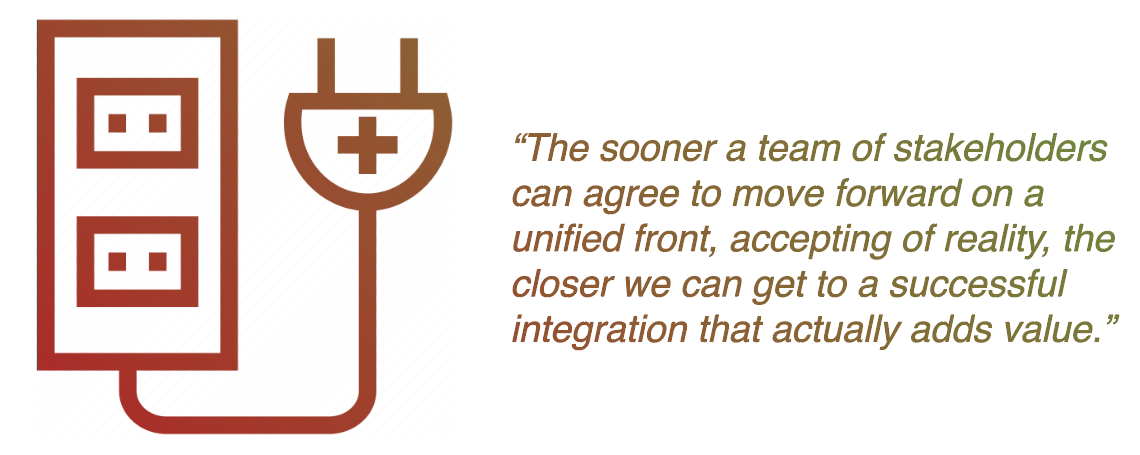Healthcare IT Integration Is Never Straightforward


We realize we are about to deflate the tires from entire salesforces in the healthcare IT space, but it would be a supreme disservice to our clients to ignore this fact: Integration is never straightforward. Despite connectivity standards that have been around for years -- be it HL7 as the Golden Oldie or new-kid-on-the-block FHIR -- there are an endless number of variables in any given interoperability or connectivity project that threaten to derail best efforts.
One of the biggest challenges we see as we step in as the integration team for our health system clients is that they don’t know what they don’t know. Components of an operating (or in-process system) are typically understood only partially, given the often piecemeal approach of bolting on components as needed and as gaps in expected (or even promised) functionality are identified. Not to mention, the turn-over in IT departments and leadership often leads to adoption of technology and vendors that would not today be considered ideal or even appropriate. These politics and realities are very real and consistently create barriers in moving forward with integrating any new technology, much less improving processes from scratch.
So How Do We Overcome The Challenges Of Integrating Healthcare Systems?
Step #1: Acknowledge The Elephant In The Room
Before any real progress can take place on a integration project, everyone at the table, all the key stakeholders, must admit that current state is not perfect and that improvement is possible and desired. It’s not assigning blame, and there is no need for burning at the stake at this point. The sooner a team of stakeholders can agree to move forward on a unified front, accepting of reality, the closer we can get to a successful integration that actually adds value. (And if there is no anticipation of value-add, then one has to wonder why undertake the effort at all.)
Step #2: Identify The Black Boxes In The Current Systems Process
It’s not uncommon in a working system -- even if the incumbent system experts would put working in quotes -- to have aspects of the flow that are a bit of a mystery. Perhaps the actual integration method is unknown, the author is long gone, or the reasoning for a piece in the puzzle is utterly questionable. There must be documentation of these risk points -- and acknowledgement of them as such -- because it is not uncommon for these lingering question marks to rear their ugly heads as late as UAT. This is a dismal time to address these gaps, as overcoming them may go as far as to necessitate another solution entirely.
Nothing will more certainly blow a budget or a go-live than realizing far too late that existing connectivity is unreliable or dismal at best. When integrating into an already-complex system of components, APIs, and products (and the vendors that come with them), it’s non-negotiable that technical specs are well documented. Pain points may still exist -- and may very well be the reason for the integration efforts on the table -- but until the technical workflow spec is ironclad, there is potential to absolutely hemorrhage money in the form of costly repeated testing cycles, engineers rewiring connections, and missed client/account deliverables.

Step #3: Scope Cannot Waiver To Make Integration Deadlines
Once the core project team for a health system integration decides on scope, it has to be considered written in stone. We know, that is always the intention. But a laser-focused Integration Project Owner will make sure that Scope Creep doesn’t occur in several key ways:
- Budget is realistic to prevent bottlenecks
- SOW is clear and an end-point is defined
- Project sponsors are committed to success
- Requirements are precise, testable, and prioritized by project phase
- Technical human resources are capable, available, and engaged
- Vendors are available and playing nice
Prepare for the fact that would-be stakeholders will start coming out of the woodwork when word gets around that changes are afoot. There is the perception that the time is now to get in change requests while a project is already underway, but these “small” asks can quickly stack up and start to threaten the delivery timeline. You can’t please everyone, and you don’t have enough resources to tackle an endless list of requirements, especially if they don’t add significant business or workflow value. A firm, focused objective driving integration of healthcare systems -- whether it’s an ERP system, a new PACS viewer, a clinical decision support plug-in, or a billing solution -- is perhaps the best insurance policy out there for near-time delivery of a project of this scope.
Mindset Is Everything
The key take-away here is that mindset plays a critical role in the success (or failure, unfortunately) of healthcare IT integration efforts. The challenge is rarely the technology itself, but rather the understanding of what is reality. Don’t hang your hat on should. Pursue commitment, humility, and precision, and you’ll find yourself in a far better position post-integration than you envisioned at the onset.

